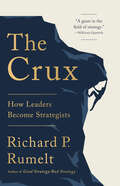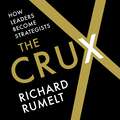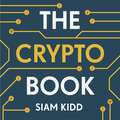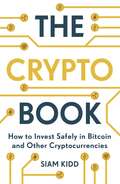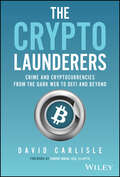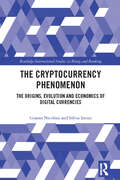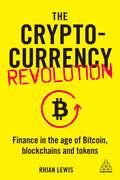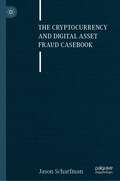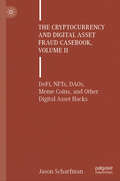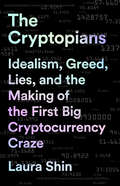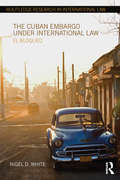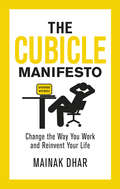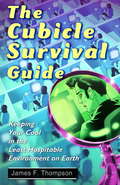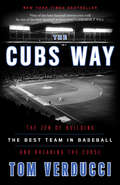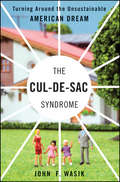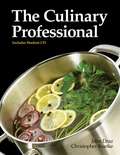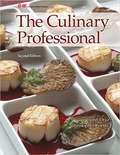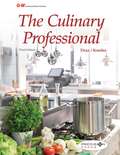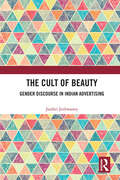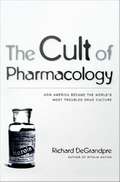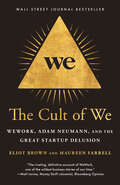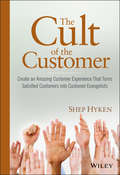- Table View
- List View
The Crux: How Leaders Become Strategists
by Richard P. RumeltFinancial Times, Best Business Books of 2022 Forbes, Best Business Books of 2022 The Next Big Idea Club, Best Leadership Books of 2022 The Globe & Mail, Best Management Books of 2022The paradigm-busting theory for doing strategy. What passes for strategy in too many businesses, government agencies, and military operations is a toxic mix of wishful thinking and a jumble of incoherent policies. Richard P. Rumelt&’s breakthrough concept is that leaders become effective strategists when they focus on challenges rather than goals, pinpointing the crux of their pivotal challenge—the aspect that is both surmountable and promises the greatest progress—and taking decisive, coherent action to overcome it. Rumelt defines the essence of the strategist&’s skill with vivid storytelling, from how Elon Musk found the crux that propelled the success of SpaceX to how the American military came to grips with the weaknesses of its battle strategy. Musk&’s core challenge, for example, was rocket reusability. His intense focus on the soft landing of SpaceX&’s rockets enabled them to be used again—radically reducing the cost of putting a pound in orbit. Musk&’s strategy was not based on how value is created or how to position SpaceX in its industry. It was a design foraction, the mental maneuver that focuses energy on what really made a difference through understanding the crux and creating an effective response that led to breakthrough.
The Crux: How Leaders Become Strategists
by Richard RumeltThe most important part of a leader's job is to set in motion the actions today that will build a better future tomorrow - in other words, strategy. But how do leaders become strategists?In this ground-breaking book, Richard Rumelt, the world's leading authority on strategy, shows how finding the crux of a challenge is the essence of the strategist's skill. The crux is the key issue where action will best pay off, and Rumelt reveals how to pinpoint it so you can focus energy on what really matters. Drawing on decades of professional and academic experience, and through vivid storytelling - from Elon Musk's decision-making to Netflix's industry dominance - Rumelt illuminates how leaders can overcome obstacles, navigate uncertainty and determine the best pathforward.Strategy is not about setting financial targets, statements of desired outcomes, or performance goals, it is about finding the crux and taking decisive, coherent action.
The Crypto Book: How to Invest Safely in Bitcoin and Other Cryptocurrencies
by Siam KiddTHE CRYPTO GOLD RUSH IS ONLY JUST BEGINNING... Blockchain technology and the cryptocurrencies it enables are being described by some people as the biggest thing since the internet, but very few people understand it, or the opportunities it brings. Enter this down-to-earth guide to understanding what cryptocurrencies are, why it matters, and how to make money from them. This book is for everyone who has heard of bitcoin and cryptocurrencies, wants to learn more - and make money on the back of it. Believe it or not, if you bought $1,000 of Bitcoin in 2010, you would now be worth over $220m! This has left the public stunned. People around the world are asking "What on earth is a crypto?", "Should I buy some Bitcoin?", "How do I even buy some cryptocurrencies?", "Isn't this just one big bubble?" and more. Siam Kidd is one of the world's leading authorities on how to safely invest in cryptocurrencies. He runs The Realistic Trader, home to the world's best crypto investing course for beginners with a community of followers from around the globe. He created this book to lift up the crypto bonnet in order to reveal, explain and illustrate everything you really need to know about this fascinating market. You'll learn: · What all this Crypto stuff is · Why it exists · Where this industry is going in the future · How it will positively change your life · The pitfalls and errors every newbie makes · And importantly, how to safely play in this market if you so wish to have a dabble with some risk capital! This book does all that without boring you with mathematics and 'Geek Speak'. CRYPTOCURRENCIES ARE THE BIGGEST OPPORTUNITY OF YOUR LIFETIME
The Crypto Book: How to Invest Safely in Bitcoin and Other Cryptocurrencies
by Siam KiddTHE CRYPTO GOLD RUSH IS ONLY JUST BEGINNING...Blockchain technology and the cryptocurrencies it enables are being described by some people as the biggest thing since the internet, but very few people understand it, or the opportunities it brings. Enter this down-to-earth guide to understanding what cryptocurrencies are, why it matters, and how to make money from them.This book is for everyone who has heard of bitcoin and cryptocurrencies, wants to learn more - and make money on the back of it. Believe it or not, if you bought $1,000 of Bitcoin in 2010, you would now be worth over $220m! This has left the public stunned. People around the world are asking "What on earth is a crypto?", "Should I buy some Bitcoin?", "How do I even buy some cryptocurrencies?", "Isn't this just one big bubble?" and more.Siam Kidd is one of the world's leading authorities on how to safely invest in cryptocurrencies. He runs The Realistic Trader, home to the world's best crypto investing course for beginners with a community of followers from around the globe. He created this book to lift up the crypto bonnet in order to reveal, explain and illustrate everything you really need to know about this fascinating market. You'll learn:· What all this Crypto stuff is· Why it exists· Where this industry is going in the future· How it will positively change your life· The pitfalls and errors every newbie makes· And importantly, how to safely play in this market if you so wish to have a dabble with some risk capital! This book does all that without boring you with mathematics and 'Geek Speak'.CRYPTOCURRENCIES ARE THE BIGGEST OPPORTUNITY OF YOUR LIFETIME"The future of money is digital currency." "Bitcoin is a technological tour de force." Bill Gates, Founder of Microsoft
The Crypto Book: How to Invest Safely in Bitcoin and Other Cryptocurrencies
by Siam KiddTHE CRYPTO GOLD RUSH IS ONLY JUST BEGINNING...This book is for everyone who has heard of bitcoin and cryptocurrencies, wants to learn more - and make money on the back of it. Believe it or not, if you bought $1,000 of Bitcoin in 2010, you would now be worth over $220m! This has left the public stunned. People around the world are asking "What on earth is a crypto?", "Should I buy some Bitcoin?", "How do I even buy some cryptocurrencies?", "Isn't this just one big bubble?" and more.Siam Kidd is one of the world's leading authorities on how to safely invest in cryptocurrencies. He runs The Realistic Trader, home to the world's best crypto investing course for beginners with a community of followers from around the globe. He created this book to lift up the crypto bonnet in order to reveal, explain and illustrate everything you really need to know about this fascinating market. You'll learn:* What all this Crypto stuff is* Why it exists* Where this industry is going in the future* How it will positively change your life* The pitfalls and errors every newbie makes* And importantly, how to safely play in this market if you so wish to have a dabble with some risk capital! Blockchain technology and the cryptocurrencies it enables are being described by some people as the biggest thing since the internet, but very few people understand it, or the opportunities it brings. Enter this down-to-earth guide to understanding what cryptocurrencies are, why it matters, and how to make money from them.This book does all that without boring you with mathematics and Geek Speak.
The Crypto Launderers: Crime and Cryptocurrencies from the Dark Web to DeFi and Beyond
by David CarlisleRe-discover the crypto underground In The Crypto Launderers: Crime and Cryptocurrencies from the Dark Web to DeFi and Beyond, renowned anti-money laundering and counter-terrorist financing expert David Carlisle delivers a fascinating breakdown of the impact of crime on the world of Bitcoin and other cryptocurrencies. Tracking the history and evolution of crypto crime from the rise of the Dark Web to the present day, Carlisle recounts how an increasingly complex money laundering ecosystem has taken root in the crypto space. He describes in vivid detail how North Korean cyber thieves, Russian hackers, narcotics traffickers, and other illicit actors have moved billions of dollars’ worth of cryptocurrencies through the blockchain, exploiting new technological innovations to profit from their crimes. In response, regulators, private industry, and law enforcement have begun fighting back against bad actors abusing cryptocurrencies – scoring critical victories along the way, but also igniting important and sometimes fierce debates about the future of innovation, finance, and the law. The author explains: A wide variety of technologies exploited by criminals, including mixers, privacy coins, Bitcoin ATMs, decentralized finance applications, and NFTs The rise of ransomware and the industrialization of the cybercriminal ecosystem How the transparency of the blockchain leaves criminals vulnerable to detection, while fueling controversial debates about financial privacy Emerging innovations, such as the rise of the metaverse, that could shape the future of crypto crimeAn engrossing and comprehensive analysis of the intersection of crime, technology, and finance, The Crypto Launderers will prove impossible to put down for readers with an interest in law, finance, tech, and the blockchain – as well as for anyone with even a passing interest in cryptocurrencies.
The Cryptocurrency Phenomenon: The Origins, Evolution and Economics of Digital Currencies (Routledge International Studies in Money and Banking)
by Gianni Nicolini Silvia IntiniThis book provides a comprehensive analysis of the cryptocurrency phenomenon from a financial/monetary point of view. It offers a unique slant in at least two ways, with the financial perspective as the reference point. An examination of the technicalities surrounding blockchain and the mining of cryptocurrencies is included, but the reading is oriented to those who seek to better understand how these technical issues help to explain the functioning and the potential of cryptocurrencies, without touching on coding aspects. Moreover, the book addresses cryptocurrencies as an evolution of the concept of money, and it frames the analysis to give readers all the knowledge needed to connect the cryptocurrency phenomenon with traditional monetary theories. In so doing, cryptocurrencies are not considered as a completely disconnected trend, set apart from traditional financial systems, but as innovations that will push the concept of money forward, without dismantling previous foundations. The book also includes a discussion on central banks, and stresses how their initial diffidence toward cryptocurrencies has turned into a more active approach that includes projects to develop the so-called Central Bank Digital Currencies (CBDC), thereby completing the analysis of the state of the art of the cryptocurrency surge. The mix of theoretical content on the concept of money, the description of payment tools and the functioning of the payment industry, and the analysis of blockchain and the cryptocurrency markets makes the book interesting reading for researchers, scholars and students of economics, finance, or business, enabling them to develop the ability to understand the dynamics of the cryptocurrency phenomenon and its possible evolution.
The Cryptocurrency Revolution: Finance in the Age of Bitcoin, Blockchains and Tokens
by Rhian LewisThe world of cryptocurrencies and blockchains was initially viewed as a niche space of little interest to mainstream business and finance sectors. With major banks now licensed to provide cryptocurrency custody solutions, and everyone from Facebook to governments using the underlying technology to create their own digital currencies, this has undoubtedly changed. The Cryptocurrency Revolution explains the most important takeaways from the continued growth of digital currencies and blockchain technology and explores the transformative possibilities of borderless payments, decentralized finance ('DeFi') and machine-to-machine transactions.Written in jargon-free and accessible language, this book examines the key value proposition of Bitcoin and other cryptocurrencies and how decentralized technologies could enable banks and financial institutions to become more efficient. It looks at the potential impact of company-backed virtual currencies (such as Facebook's Libra) and how governments and regulators around the world are reacting to these innovations. With discussion of the principles of tokenomics and the difference between public and private blockchains, The Cryptocurrency Revolution is the essential guide for those wishing to understand the threats and opportunities of the changing world of payments and finance.
The Cryptocurrency and Digital Asset Fraud Casebook
by Jason ScharfmanCryptocurrencies and digital assets have continued to gain widespread acceptance from both retail and institutional investors. With this rapid growth in both the crypto and digital asset spaces, there has also been an unfortunate steady drumbeat of fraudulent activity. It has been reported that in 2021 alone over $14 billion in crypto was stolen from investors. Frauds have touched all aspects of the crypto universe ranging from outright Bitcoin theft, pig butchering, and wallet phising to DeFi rug pulls, exchange hacks, mining scams and NFT fraud. The Cryptocurrency and Digital Asset Fraud Casebook will provide up to date information and analysis on fraudulent activity in the crypto space.
The Cryptocurrency and Digital Asset Fraud Casebook, Volume II: DeFi, NFTs, DAOs, Meme Coins, and Other Digital Asset Hacks
by Jason ScharfmanCryptocurrencies and digital assets have continued to gain widespread acceptance from both retail and institutional investors. As part of this continued growth, there has been an unfortunate series of ongoing and increasingly sophisticated frauds, Ponzi schemes, and hacks that have cost investors billions of dollars. Since the publication of the original Cryptocurrency and Digital Asset Fraud Casebook, conservative estimates indicate that there have been thousands of new digital asset fraud cases that have contributed to billions in broadening losses in space. Beyond the digital asset space, cryptocurrency-related scams also continue to present increasingly meaningful threats to traditional finance institutions, the global economy, and national security, as well. These new challenges, combined with the ongoing evolving regulatory environment for digital assets, create an environment where there is a continued need for the up-to-date information and analysis of real-world case studies. It includes an up-to-date analysis of recent case studies in cryptocurrency and digital asset fraud alongside an analysis of recent decentralized finance (DeFi) hacks, smart contract attacks, and rug pulls. This book reviews the impact of digital asset bankruptcies, the FTX fraud, and the industry-wide post-FTX fallout on the growth of cryptocurrency fraud. It also examines the explosive growth of cryptocurrency romance scams, pig butchering, and related organized crime money laundering efforts and includes a related exclusive case study. Offering an in-depth examination of digital asset frauds in the gaming, metaverse, and NFT spaces, it also covers Decentralized Autonomous Organization (DAO) fraud, smart contract attacks, dApp scams, crypto asset manager investment fraud, mining fraud, honeypots, meme coins, and artificial intelligence-based digital asset fraud. Leveraging the author’s experience analyzing and implementing compliance and operations best practices with a variety of cryptocurrency and digital asset projects and consulting with international regulators on blockchain and digital asset policy, this book will be of interest to those working throughout the cryptocurrency and digital asset space including Web 3.0 builders and service providers including lawyers, auditors, blockchain infrastructure, regulators, governments, retail investors, and institutional investors.
The Cryptopians: Idealism, Greed, Lies, and the Making of the First Big Cryptocurrency Craze
by Laura ShinThe story of the idealists, technologists, and opportunists fighting to bring cryptocurrency to the masses.In their short history, Bitcoin and other cryptocurrencies have gone through booms, busts, and internecine wars, recently reaching a market valuation of more than $2 trillion. The central promise of crypto endures—vast fortunes made from decentralized networks not controlled by any single entity and not yet regulated by many governments.The recent growth of crypto would have been all but impossible if not for a brilliant young man named Vitalik Buterin and his creation: Ethereum. In this book, Laura Shin takes readers inside the founding of this novel cryptocurrency network, which enabled users to launch their own new coins, thus creating a new crypto fever. She introduces readers to larger-than-life characters like Buterin, the Web3 wunderkind; his short-lived CEO, Charles Hoskinson; and Joe Lubin, a former Goldman Sachs VP who became one of crypto&’s most well-known billionaires. Sparks fly as these outsized personalities fight for their piece of a seemingly limitless new business opportunity.This fascinating book shows the crypto market for what it really is: a deeply personal struggle to influence the coming revolution in money, culture, and power.
The Cuba Interviews: Conversations on Foreign Investment and Economic Development
by T. K. HernándezThis book is a collection of meticulously gathered interviews with government officials, ambassadors, and executives involved in foreign investment and economic development in Cuba. The interviews, many for the first time with a foreign journalist, are valuable from a historical perspective and as a story of development. It offers an “open window” on Cuba into a crucial segment of the country’s economy, erroneously perceived by some as “shuttered” to the outside world. This work is structured by the contextual history of Obama’s opening with Cuba, the bleak days of Trump, the Havana Syndrome, the onset of the pandemic, the election of Biden, and his “unmet promises”, through to economic recovery of the island under the post-pandemic normal. It highlights the work of the ones who lead and invest, create opportunities for themselves and others, initiate change, trigger sustainable development, build infrastructure, improve lives, strengthen the economy, lessen suffering, and create hope. They stimulate forward progress. These are the visionaries with plans seeking to realize the full potential of Cuba, driving a new era of sustainable development and growth. By filling those gaps, this work is an important supplement for any future analysis seeking to examine the country’s potential. The book is divided into parts: government, economy, foreign investment, industrial zones, banking, law, and business, followed by interviews with top executives from Cuba’s primary sectors. This “open window” on Cuba is a compelling fresh take that shows that Cuba is open for serious business.
The Cuban Embargo under International Law: El Bloqueo (Routledge Research in International Law)
by Nigel D. WhiteThe United States embargo against Cuba was imposed over fifty years ago initially as a response to the new revolutionary government's seizure of US properties, which was viewed by the US as a violation of international law. However, while sanctions can be legitimate means of enforcing established norms, the Cuban embargo itself appears to be the wrongful act, and its persistence calls into question the importance and function of international law. This book examines the history, legality and effects of US sanctions against Cuba and argues that the embargo has largely become a matter of politics and ideology; subjecting Cuba to apparently illegitimate coercion that has resulted in a prolonged global toleration of what appears to be a serious violation of international law. The book demonstrates how the Cuban embargo undermines the use of sanctions world-wide, and asks whether the refusal of world governments to address the illegality of the embargo reduces international law to tokenism where concepts of sovereign equality and non-intervention are no longer a priority. Despite the weaknesses of international law, Nigel D. White argues that in certain political conditions it will be possible to end the embargo as part of a bilateral agreement to restore normal relations between the US and Cuba and, furthermore, that such an agreement, if it is to succeed, will have to be shaped by the broad parameters of law and justice. As a fierce re-evaluation of international law through the story of a country under siege, this book will be of great interest and use to researchers and students of public international law, international relations, and US and Latin American politics.
The Cubicle Manifesto: Change the Way You Work and Reinvent Your Life
by Mainak DharWelcome to THE CUBICLE. The desk space you occupy for hours on end. Where creativity is dead and stress levels are high. Where you feel guilty for leaving, but reluctant to arrive. Where you eat lunch, plan, strategize and phone home to say how late you'll be tonight. Is this the place you'd really like to be? Is there a better way to work?Stressed office worker Mayukh can't believe his misfortune when his computer gets infected by a virus. With enough work on his plate to last a lifetime, he can do without computer malfunctions. However, the virus seems to have its own agenda and it soon starts a revolution that will change how Mayukh works forever.The Cubicle Manifesto is a business parable for the modern age that will transform the way you work. Essential reading for anyone who wants to reduce stress and achieve better work-life balance. Read this book and join the revolution. #endcubicletyranny
The Cubicle Survival Guide: Keeping Your Cool in the Least Hospitable Environment on Earth
by James F. ThompsonHelp. . . . Cubicle Life Is Killing Me! Leaving no stone unturned, no ergonomic chair unadjusted, and no leftovers in the communal fridge uneaten, this hilarious guide to cubicle life will be the salvation for the more than forty million Americans stuck in cubicles. By turns uproariously funny and enormously useful, each chapter tackles a different area of cubicle life and includes a “cube tip,” a quiz, illustrations, and examples that will have you laughing out loud. Discover • how not to disturb colleagues with unwanted sounds and smells, such as the crunch-crunch of your sour-cream-and-onion chips and the unmistakable odor of your spicy Thai shrimp • how to knock when visiting other cubicles and how to devise politically correct ways of saying “Do not disturb” • the do’s and definite don’ts of cubicle decoration • how to set up a security system that will rebuff potential thieves The Cubicle Survival Guidecould very well change your life and set you climbing the corporate ladder to success!* * Results not guaranteed. Pay raises and promotions are up to your boss, but using this book couldn’t hurt. Praise forThe Cubicle Survival Guide: “A spiritual air conditioner for the cubicled soul. ” — Turk Regan, author ofPimp My Cubicle:Take Your Workspace from Boring to Bling! "James Thompson’sThe Cubicle Survival Guideoffers the rare, and definitely appreciated, combination of laugh-out-loud humor and sound advice for surviving the jungle that is Corporate America. On some days, there’s nothing more motivating to fresh air-starved cube dwellers than a book that will simply crack them up. This is that book. ” — Alexandra Levit, Author,TheyDon’t Teach Corporate in College "If you must work (and I don't recommend it),The Cubicle Survival Guideprovides a wonderful way to slack off and stay entertained. You can easily kill two weeks with this book. " — Josh Aiello, Author,60 People to Avoid at the Water Cooler “Thompson provides a humorous yet thought-provoking look at what employees in today's large organizations must deal withbesidestheir jobs. ” — Malcolm O. Munro, Author,From Cave to Cubicle From the Trade Paperback edition.
The Cubs Way: The Zen of Building the Best Team in Baseball and Breaking the Curse
by Tom Verducci<P>With inside access and reporting, Sports Illustrated senior baseball writer and FOX Sports analyst Tom Verducci reveals how Theo Epstein and Joe Maddon built, led, and inspired the Chicago Cubs team that broke the longest championship drought in sports, chronicling their epic journey to become World Series champions. It took 108 years, but it really happened. The Chicago Cubs are once again World Series champions. <P>How did a team composed of unknown, young players and supposedly washed-up veterans come together to break the Curse of the Billy Goat? Tom Verducci, twice named National Sportswriter of the Year and co-writer of The Yankee Years with Joe Torre, will have full access to team president Theo Epstein, manager Joe Maddon, and the players to tell the story of the Cubs' transformation from perennial underachievers to the best team in baseball. <P>Beginning with Epstein's first year with the team in 2011, Verducci will show how Epstein went beyond "Moneyball" thinking to turn around the franchise. Leading the organization with a manual called "The Cubs Way," he focused on the mental side of the game as much as the physical, emphasizing chemistry as well as statistics. To accomplish his goal, Epstein needed manager Joe Maddon, an eccentric innovator, as his counterweight on the Cubs' bench. A man who encourages themed road trips and late-arrival game days to loosen up his team, Maddon mixed New Age thinking with Old School leadership to help his players find their edge. <P>The Cubs Way takes readers behind the scenes, chronicling how key players like Rizzo, Russell, Lester, and Arrieta were deftly brought into the organization by Epstein and coached by Maddon to outperform expectations. Together, Epstein and Maddon proved that clubhouse culture is as important as on-base-percentage, and that intangible components like personality, vibe, and positive energy are necessary for a team to perform to their fullest potential. Verducci chronicles the playoff run that culminated in an instant classic Game Seven. He takes a broader look at the history of baseball in Chicago and the almost supernatural element to the team's repeated loses that kept fans suffering, but also served to strengthen their loyalty. <P>The Cubs Way is a celebration of an iconic team and its journey to a World Championship that fans and readers will cherish for years to come. <P><b>A New York Times Bestseller</b>
The Cul-de-Sac Syndrome
by John F. WasikAn incisive look at the consequences of today's costly and damaging suburban lifestyleIn The Cul-de-Sac Syndrome, Bloomberg News' John Wasik exposes the economic, cultural, environmental, and health problems underlying life in suburbia. Wasik provides powerful insights into how the U.S. suburban lifestyle has become unsustainable and what can be done to salvage it. His observations are firmly grounded in exclusive on-the-ground research, interviews with thought leaders, and the latest studies and statistics. The bookExposes the untold truths about suburban home ownership: green isn't always so green, life isn't cheaper after accounting for gas, water, and taxes, and modern suburban living isn't so idyllic considering the toll it takes on our healthIncludes exclusive research and analysis by experts in the field that debunks the many myths associated with suburban livingExplores innovative solutions being developed in cities across the countryThe American Dream of moving further from a city to buy a bigger house and find better schools has become a costly nightmare. The Cul-de-Sac Syndrome examines why and what can be done.
The Culinary Professional
by Christopher Koetke John DrazNIMAC-sourced textbook <P><P>The first edition of The Culinary Professional rated high in user satisfaction. With this new, updated edition, authors and chefs John Draz and Christopher Koetke have continued to focus on the core content that provides students with the knowledge they need for a career in the culinary arts. Additionally, they have added chapters to address current industry topics: Sustainability in the Kitchen and Analyzing Cuisines.
The Culinary Professional
by Christopher Koetke John DrazStep-by-step techniques for essential culinary skills, Repeated features on history, workplace issues, safety and sanitation, science and technology, culture, culinary tips, trends, health, and math, Activities on workplace math, problem-solving, and critical thinking challenges, as well as mini labs, About culinary history.
The Culinary Professional (Third Edition)
by Christopher Koetke John DrazThe Culinary Professional is the first step on the path to a career in the culinary field. It will provide you with the necessary skills for more advanced class work and expose you to the world of professional cooking. The foodservice industry, which employs most culinary professionals, is large and diverse. This text begins with an introduction to that industry's opportunities and challenges. You will learn what it takes to succeed in this growing field. Before you begin to cook, you should know how to be safe in the kitchen. Early chapters will explain how to protect your health and safety as well as that of your coworkers and customers. You will learn how to find a job and what is expected of you as an employee. A new chapter explores concepts and practices that promote sustainability in the kitchen. Chefs use many tools and select from an immense array of ingredients when preparing dishes. The Culinary Professional supplies a generous number of photos and clear descriptions of the tools and ingredients used in the professional kitchen. Step-by-step directions for basic culinary skills and cooking methods appear throughout the text. The presentation of your food is nearly as important as the preparation, and for this reason, a full chapter covers the principles of plating, design, and garnishing. A new chapter explains how to analyze cuisines and explores various international cuisines. Successful chefs must be able to do more than simply prepare delicious dishes. You will learn about the importance of working with other departments and managing resources. Welcome to the first step on your path to a career in culinary!
The Cult of Beauty: Gender Discourse in Indian Advertising
by Jaishri JethwaneyThis book deconstructs the quintessential Indian woman that the advertising industry portrays across the spectrum by looking at Indian advertisements across multiple brands with a gender lens based on societal and sociological perspectives. It delves into various critical issues like the differences between culture-defined gender roles/expectations and women’s portrayal in the ad narrative, and which product category has consistently portrayed women as sex objects.Drawing insights from a seminal research study and Erving Goffman’s classic book ‘Gender Advertisements’, it traces the journey of three decades, beginning the 1990s – the era of liberalization in India, to map trends and patterns in Indian advertising and presents the perspectives of the creative teams and top managements across Indian and global advertising agencies. It discusses the application of a Gender Sensitivity Barometer (GSB) which the creative teams can use to find out how sensitive or insensitive the ad has been based on pre-determined indicators suggested by the GSB.This book will be useful to students, researchers and faculty working in the field of management, advertising, mass communication, psychology, gender studies and sociology. It will also be an indispensable companion to professionals from the field of advertising and related areas.
The Cult of Pharmacology: How America Became the World's Most Troubled Drug Culture
by Richard DegrandpreAmerica had a radically different relationship with drugs a century ago. Drug prohibitions were few, and while alcohol was considered a menace, the public regularly consumed substances that are widely demonized today. Heroin was marketed by Bayer Pharmaceuticals, and marijuana was available as a tincture of cannabis sold by Parke Davis and Company. Exploring how this rather benign relationship with psychoactive drugs was transformed into one of confusion and chaos, The Cult of Pharmacology tells the dramatic story of how, as one legal drug after another fell from grace, new pharmaceutical substances took their place. Whether Valium or OxyContin at the pharmacy, cocaine or meth purchased on the street, or alcohol and tobacco from the corner store, drugs and drug use proliferated in twentieth-century America despite an escalating war on "drugs. " Richard DeGrandpre, a past fellow of the National Institute on Drug Abuse and author of the best-selling book Ritalin Nation, delivers a remarkably original interpretation of drugs by examining the seductive but ill-fated belief that they are chemically predestined to be either good or evil. He argues that the determination to treat the medically sanctioned use of drugs such as Miltown or Seconal separately from the illicit use of substances like heroin or ecstasy has blinded America to how drugs are transformed by the manner in which a culture deals with them. Bringing forth a wealth of scientific research showing the powerful influence of social and psychological factors on how the brain is affected by drugs, DeGrandpre demonstrates that psychoactive substances are not angels or demons irrespective of why, how, or by whom they are used. The Cult of Pharmacology is a bold and necessary new account of America's complex relationship with drugs.
The Cult of We: WeWork, Adam Neumann, and the Great Startup Delusion
by Eliot Brown Maureen Farrell&“A juicy investigation into one of Silicon Valley&’s most-hyped fallen unicorns.&”—Time (Best Books of Summer 2021)The definitive inside story of WeWork, its audacious founder, and what its epic unraveling says about a financial system drunk on the elixir of Silicon Valley innovation—from the Wall Street Journal correspondents (recently featured in the WeWork Hulu documentary) whose scoop-filled reporting hastened the company&’s downfall. WeWork would be worth $10 trillion, more than any other company in the world. It wasn&’t just an office space provider. It was a tech company—an AI startup, even. Its WeGrow schools and WeLive residences would revolutionize education and housing. One day, mused founder Adam Neumann, a Middle East peace accord would be signed in a WeWork. The company might help colonize Mars. And Neumann would become the world&’s first trillionaire. This was the vision of Neumann and his primary cheerleader, SoftBank&’s Masayoshi Son. In hindsight, their ambition for the company, whose primary business was subletting desks in slickly designed offices, seems like madness. Why did so many intelligent people—from venture capitalists to Wall Street elite—fall for the hype? And how did WeWork go so wrong? In little more than a decade, Neumann transformed himself from a struggling baby clothes salesman into the charismatic, hard-partying CEO of a company worth $47 billion—on paper. With his long hair and feel-good mantras, the six-foot-five Israeli transplant looked the part of a messianic truth teller. Investors swooned, and billions poured in. Neumann dined with the CEOs of JPMorgan and Goldman Sachs, entertaining a parade of power brokers desperate to get a slice of what he was selling: the country&’s most valuable startup, a once-in-a-lifetime opportunity and a generation-defining moment. Soon, however, WeWork was burning through cash faster than Neumann could bring it in. From his private jet, sometimes clouded with marijuana smoke, he scoured the globe for more capital. Then, as WeWork readied a Hail Mary IPO, it all fell apart. Nearly $40 billion of value vaporized in one of corporate America&’s most spectacular meltdowns. Peppered with eye-popping, never-before-reported details, The Cult of We is the gripping story of careless and often absurd people—and the financial system they have made.
The Cult of the Customer
by Shep HykenIn today's competitive business climate, you can't just satisfy your customers. You have to be better than that, giving them experiences that they won't forget. Author Shep Hyken has spent twenty-five years studying great companies and the evangelists they create. In The Cult of the Customer, Hyken shows how to design a strategy that leads both customers and employees through five distinct cultural phases - from "uncertainty" to "amazement." By presenting dozens of case studies that show how great companies made this journey, Hyken identifies the critical internal and external changes that allowed them to build a Cult of the Customer - and shows how you can do it too.Hyken's message is both powerful and timely: the happier your customers and employees are, the more successful your company will be. The Cult of the Customer is your guide to creating a customer-focused culture that turns satisfied customers into customer evangelists.
